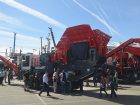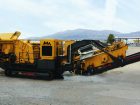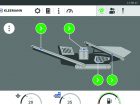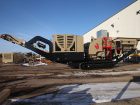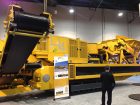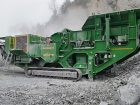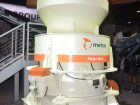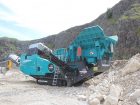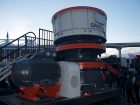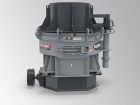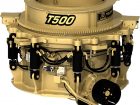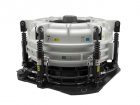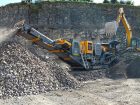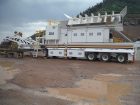
Products & Equipment
Pits & Quarries
Crushing Report 2017
Cost per ton and safety are king for aggregate producers.
June 13, 2017 By Andrew Snook
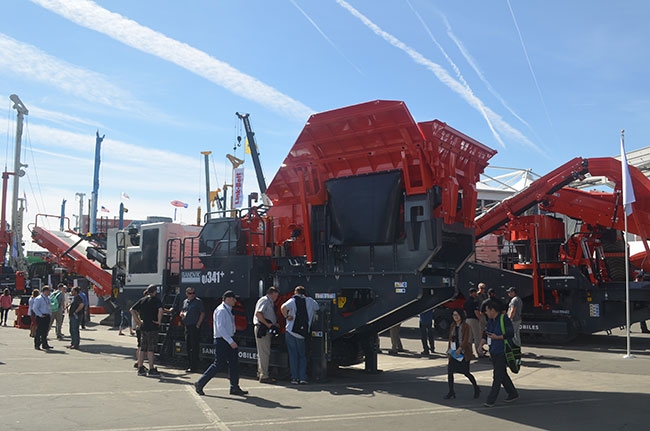 Improving cost per ton, enhanced safety features and automation are all top of mind for aggregate producers when it comes to investing in crushing technologies.
Improving cost per ton, enhanced safety features and automation are all top of mind for aggregate producers when it comes to investing in crushing technologies. June 13, 2017 – If there’s any one thing the majority of crushing manufacturers can agree on, it’s that cost per ton is king when it comes to what their customers are looking for in their crushing fleets.
“Everything comes down to cost per ton and what can you do to reduce that for the customer,” explains Stephen Whyte, product manager of fast track and global track products for KPI-JCI and Astec Mobile Screens. “That’s not something new, I just think a lot of the information that helps them make their purchasing decisions is easier to get a hold of than it previously was.”
One of the ways producers are looking to increase their cost per ton as well as other operational efficiencies in their pits and quarries is through increased investment in automation.
“I think at the present when you start focusing in on key points of what dealers, distributors and end users are looking at – and big quarries and mining environments as well – it’s cost per ton and health and safety,” says Wayne van Antwerpen, crusher technology product manager for Terex Materials Processing Systems (Terex MPS), adding that automation will play a key role in the continued advancements of both. “Be it the static, portable or tracked, the biggest thing is automation… you’re going to see it more and more.”
“The trend over the last 10 years, at least, has been that most of the producers we come across are looking for more and more advancement in automation,” adds Mike Schultz, crushing product manager for Superior Industries. “They want the equipment to run independently and alert the end users of any harmful conditions, but otherwise, sit there and run and be automated.”
One factor increasing the demand for automated technologies is an aging workforce, particularly when it comes to maintenance personnel and operators.
“There’s a lot of experience that has retired in the last three to five years and we see that trend continuing, so we’re looking to design things in the equipment that will help with the training needs for new employees coming in,” says Matt Haven, president of Telsmith.
To assist new employees, Telsmith has focused on designing its latest crushers to be less maintenance intensive than they were in the past. The company also incorporated improved data collection into its control systems so maintenance and preventive maintenance is more predictable for staff; and to assist less experienced operators with meeting their targets.
“We built in self-diagnostics so if there is a problem it doesn’t take the electrical engineer to come out and troubleshoot,” Haven explains. “The operator is informed whether one of the sensors are closed or if there’s a cable that doesn’t appear to be communicating right. That’s helped them to make it very simple for the operations people to keep things operating. On the production side, we’ve tried to take the experience of an operator that’s been managing things for years and build that into the control scheme.
“Again, it doesn’t take a super-experienced operator to make sure everything is within specifications. So that intelligence built into the control system gives them some key performance indicators to measure whether everything is operating properly or not.”
Safety top of mind
Keeping employees safe is still very much a priority for crushing manufacturers.
Terex’s van Antwerpen says that safety is as top of mind for producers as cost per ton when it comes to what they’re looking for in their crushing equipment, and that increasing automation is a key part of the safety solution.
“When you start really automating things correctly, you start pulling out people… keeping human interaction to your plot as little as possible,” he explains.
“Folks should feel comfortable going in and working on the equipment,” adds Schultz. “Obviously you’re always going to have your lockout and tag out procedures, but we try and design into our machines an ease of access… what we try and do is put ourselves in the spot of the guy holding the wrench or torch and provide them with the easiest access to the machine as possible.”
Hybrid technologies
When it comes to introducing hybrid technologies into crushing equipment, this trend is expected to continue growing moving forward.
“I think you see that right throughout the industry,” says Whyte. “If you look at what John Deere, CAT, and Volvo are doing, it’s getting bigger and bigger all the time.”
Whyte says that one factor that is key to the successful introduction of hybrid technologies into the marketplace is reducing the number of new parts a crusher will have.
KPI-JCI recently introduced hybrid technologies into its GT440 horizontal shaft impact crusher and GT205 multi-frequency screen.
“We’re able to keep about 90 per cent of the machine the same as our diesel hydraulic machine, so our dealers are not stocking a lot of new spares,” Whyte says, adding that anyone who has invested in training on his company’s standard crusher can carry that knowledge over to their hybrid model. “Anyone who has had some training on the standard machine can operate this machine.”
Another key to selling hybrid technologies to new or exiting customer is being to show them what they can save on their bottom lines.
“We’ve been developing a lot of ROIs to try and help customers make decisions,” Whyte says. “We can take it over 1,000 hours, or a couple of years, and give them a pretty good estimate on what they’re going to be saving.”
With the way technologies in the industry are constantly evolving, van Antwerpen says that no one manufacturer will always be leading the pack.
“I don’t think one individual OEM will lead all the time, I think they’ll leapfrog each other,” he says.
And with every new technology comes the challenges of proving its worth to an industry not always known for embracing change quickly.
“People are very cautious in our industry,” Haven says. “It always takes a little longer than you think it should, but once people see how it’s of benefit to them they get very excited quickly.”
THE LATEST CRUSHERS FOR AGGREGATE OPERATIONS
McCloskey International
The new I54v3 Impact Crusher features an open chassis for ease-of-access; optional full length main conveyor or optional underpan under the crushing chamber conveyor; hydraulic adjustable magnet; and a new larger double deck prescreen for efficient fines removal. Main and side conveyors are now wider to accommodate a larger volume of prescreen discharge material, and to allow for better discharge from the crushing chamber. The I54v3 is designed for use in asphalt recycling, concrete recycling, rock crushing, construction and demolition.
www.mccloskeyinternational.com
Powerscreen
From the feeder right through to the product conveyor, Powerscreen¹s Trakpactor 550 horizontal impact crusher has been designed to promote an easy and effective flow of material to minimize any potential material build-up and thereby ensure maximum uptime. The optional pre-screen unit has incorporated the same leading technology that has made the Powerscreen mobile screen range world-renowned. The 2.1-m pre-screen length and large open area allows the maximum amount of fines to be removed. Additional features such as the hydraulic inlet lid and the automatic adjustment system ensure ease of use for the operator, whilst the auto rotation system for blow bar changes also demonstrates the focus on machine safety. The Trakpactor 550 comes complete with the Pulse Intelligence system as standard. Powerscreen Pulse is a remote monitoring, fleet management system allowing crushing and screening equipment operators and owners to have access to key data. Analyzing this data can improve machine operation, increase uptime and allow in-depth reporting and fleet management.
www.powerscreen.com
ELRUS Aggregate Systems
The ELRUS 3054 Primary Jaw Plant’s chassis are constructed using heavy-duty WF iron that has been strapped and cambered for additional strength and support. Standard features include a removable feeder module consisting of hydraulic dumping grizzly, hopper and VGF that slide off in one or two pieces, onboard adjustable discharge conveyors, impact bed under jaw, 12 volt hydraulic levelling that enables fast set-up; and the company’s heavy duty tri-axle solid walking beam suspension for stability for moving the plant over rugged terrain.
www.elrus.com
Terex MPS
Terex’s TC1150 cone is based on the 1000 and 1300 cones but with several improvements enhancing the performance and functionality. Key features include a nominal cone head diameter of 1,150mm, gross weight of 14 tons, 65mm standard long throw (300hp) and optional 50mm short throw (250hp). Large eccentric throw helps improve product shape and increases chamber throughput producing 220 to 260 tph at 25mm CSS (Max CSS 45mm). Other improvements include a newly designed upper frame accommodating all available concave liners; and a locking ring design eliminating the need to hammer in concave retaining wedges. For the wedge ring and upper frame, the inner skirt has been better protected to accommodate for larger CSS increasing product size; and the stroke clearance has been increased, allowing larger maximum CSS and tramp clearance.
www.terexmps.com
Telsmith
The newest model in the line-up of T-Series crushers is the T500, which is designed to deliver maximum uptime availability while also minimizing maintenance costs. This 500-hp crusher contains a 356-mm (14”) maximum feed opening and is capable of processing between 285 and 775 mtph. Features, such as anti-spin and fewer cylinders than competitive crushers provide the reliability customers depend upon to maximize their processing operations.
www.telsmith.com
Superior Industries
Superior Industries new patent pending Valor Vertical Shaft Impactor (VSI) shapes aggregate, generates fines, and eliminates unsound material. Models are available up to 800 tph and maximum feed sizes up to 8”. The cartridge style, right angle pinion gearbox allows for a safe deck-mounted motor arrangement; and the hydraulically-powered lifting lid allows for safe and easy access to the crushing chamber. Three different crushing chamber options are available, including rock on rock, rock on anvil, and shoe on anvil.
www.superior-ind.com
KPI-JCI
KPI-JCI and Astec Mobile Screens’ new hybrid technology was released on the GT440 horizontal shaft impact crusher. The new patent pending GT440 Hybrid features the company’s 42×40 horizontal shaft impact crusher, which can be offered in a 3 or 4-bar rotor configuration. The new hybrid technology alllows the user to switch the unit to run completely from line power, or a generator, or diesel/hydraulic. With the new hybrid designs, 80 per cent of the units are the same as the standard diesel hydraulic units, limiting the new spare parts a dealer or customer must stock. The company’s tracked impactors offer continuous crushing and tracking. The unit’s Overload Protection System allows end users the ability to maximize performance and production, by ensuring the unit is running at maximum capacity. The new hybrid technology is also available on the GT205 multi-frequency screen.
www.kpijci.com
Tesab
Tesab’s 700i Jaw Crusher is now easier to manoeuvre on site and transport due to its new weight (46,720 kg) and dimensions (11’ 4” x 10’ 9” x 54’ 9”) while still maintaining the original jaw crushing unit. It features Tesab’s new step deck vibrating feeders, allowing a higher throughput tonnage, improved material separation quality and the ability to handle dry, damp or wet material. The 700i can be fed by excavator as a standalone unit and also integrates into the Tesab range of secondary crushers and screeners. It offers a production rate of 350 tph; a maximum feed size of 700mm; and reduction ratio up to 4:1.
www.tesab.com
Keestrack
Keestrack’s H4 Cone Crusher is a light, compact plant that is fully automated to produce up to 250 tph at maximum feed sizes of 7 in. The plant can be equipped with a pre-screen with fines chute and with a three-deck secondary screen module with recycling conveyor for closed-circuit processing. A big feeder volume, large screening areas and high stockpile capacities allow very productive operations as an in-line or standalone unit. The H4 features a hybrid diesel-electric drive concept that guarantees economic fuel consumption, and the recently introduced full-hybrid version H4e even allows full electric operation through mains or an external gen set.
www.frontline-machinery.com
Sandvik
Sandvik’s CS550 stationary cone crusher is a powerful secondary stage crusher for 700- to 750-tonne applications. Sandvik has completely eliminated plastic backing materials in the crushing chamber and improved the maintenance ergonomics. The standard automatic setting regulation system optimizes crusher operation for efficiency and adapts to variations in feed conditions by means of continuous liner wear measurement and compensation. The Hydroset system provides automatic hydraulically powered mainshaft positioning and overload protection to permit the passage of uncrushables.
www.sandvik.com
Metso
Metso’s MX cone crusher features patented Multi-Action technology that allows for dynamic setting adjustment and wear compensation without having to stop the process. Both the piston and rotating bowl adjustments can be fully automated. End products can be measured even 10 times per second and viewed directly from the Metso IC crusher automation display. Producers can control and automate parameters such as cavity level, crusher speed, power, setting and piston pressure. It has a maximum power of 400 hp; maximum feed size of 10.5”; minimum setting of 5/16”; a 46.25” head diameter; and weighs 46,750 lb. The crusher has a maximum throughput of 430 to 600 metric tph; and sand production of 60 to 80 metric tph.
www.metso.com
Kleemann
The new Spective intuitive crushing plant control system concept from Kleemann is revolutionizing mobile crushing operations. Introduced at Conexpo-Con/Agg 2017, the Spective system is easy to understand. With the ease of using a smartphone, the operator is guided intuitively through the control system, which is a big advantage as this reduces the potential for operating errors. Data relating to machine operation can be retrieved via the control system, and diesel and lube oil fill levels, for example, can be viewed in the plant cockpit. Automatic documentation of the operating data also is provided, permitting evaluation of plant efficiency. Spective is available initially for the Mobicone MCO 11 PRO and the latest impact crushers in the Mobirex MR EVO2 jaw crusher series.
www.wirtgen-group.com/en/product-brands/kleemann
IROCK
The IROCK TC-15 impact crusher features a large hopper and is offered with optional features, including extensions and a grizzly pre-screen that can remove product via the dirt conveyor or add it back into the crushed material. The TC-15 is also available as a closed circuit unit. With a 5-foot by 12-foot double deck screen and return conveyor that swings for stockpiling, producers can create as many as four products or just one product by closing the circuit.
www.irockcrushers.com
Print this page
